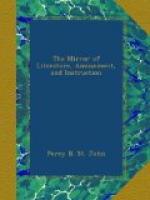As one act of public spirit generally leads to another, the erection of a new stone bridge is projected at Staines; it is to be nearer the church than the present bridge, and will afford a better view of the new structure. An elegant stone bridge was erected here in 1796, but two of the piers sinking, the bridge was taken down, and an iron one substituted; this failed, and has since been supported by wooden piles and frame-work.
[1] This is a boundary stone which marks the extent
of the jurisdiction
possessed by the City of London
over the western part of the River
Thames. It stands on
the margin of the river, in the vicinity of
Staines church, and bears
the date of 1280. On a moulding round the
upper part is inscribed “GOD
preserve the City of London, A.D. 1280.”
[2] George II. used to say when riding through Brentford,
with his heavy
guards, “I do like dis
place, ’tis so like Yarmany.”
* * * * *
THE SPECTRE’S VOYAGE.
(For the Mirror.)
“There is a part of the river Wye, between the city of Hereford and the town of Moss, which was distinguished and well known for upwards of two centuries, by the appellation of the Spectre’s Voyage; across which, so long as it retained that name, neither entreaty nor remuneration could induce any boatman to convey passengers after a certain hour of the night. The superstitious ideas current amongst the lower orders of people were, that on every evening about the hour of eight, a beautiful female figure was seen in a small vessel, sailing from Hereford to Northrigg, (a small village about three miles distant,) with the utmost rapidity, against wind and tide, or even in a dead calm—landed at the little village, returned, and vanished, when arrived at a certain part of the river, where the current is remarkably strong, about half a mile from the city of Hereford.”
—Neele’s Romance of History. See MIRROR, vol. x, page 352.
Bright shines the silver queen of night,
Upon fair Wye’s soft
stream;
Which throws a ray of heavenly light
Reflected from her beam.
Yet this smooth water, wide and clear,
This scene of sweet repose;
Erst filled the villagers with fear
As ancient story goes.




